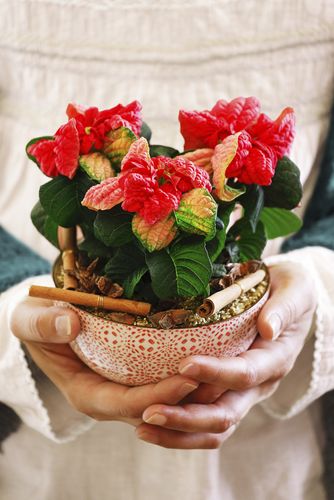Pick the right spot
In order to flourish well a poinsettia needs a warm, bright spot that is well protected from draughts. The room temperature should ideally be between 15 and 22 C. In the winter months, this light-loving plant also likes a spot with full sun in a south-facing window. “In our line of latitude there’s little danger of a poinsettia getting too much sun in the autumn and early winter months”, advises the international florist expert Klaus Wagener. “When placed near a window poinsettias can take full advantage of the sharply reduced amount of daylight in winter.” But be careful: Before opening the window to air out the room, the plant should be moved to a protected corner, as cold draughts can cause it permanent damage.
Water moderately
When watering poinsettias one rule applies: less is more. Although these plants can withstand a bit of dryness, they do not tolerate overwatering. Particularly waterlogging must be avoided at all cost. Therefore, any excess water in the saucer should be removed no more than 15 minutes after watering. Poinsettias should not be watered until there is only little moisture left in the root bale. “The easiest way to tell is by lifting up the pot”, advises Wagener. “Testing the weight of the plant will help determine if it’s time to water or not.” As a rule, a poinsettia should be given a small amount of room-temperature water every two to three days. However, if it is very warm in the room or if the plant is standing near a heater it may be necessary to water it every day. On the other hand, if the plant is bottom-watered, i.e. immersed in water to soak for a few minutes, it may not need watering again for a whole week. Tip: The smaller the plant, the more often it needs watering. Poinsettia miniatures must be watered every day, as they only have a small amount of soil to use as a water reservoir.
Pay attention when shopping
Sometimes a poinsettia will drop its leaves soon after being brought home, although you have done everything right. In this case, it can be assumed that the plant’s needs were not being met in the retail environment. To avoid such unpleasant surprises, check to see if the poinsettia has been placed in a spot that is protected from draughts and cold, and have it wrapped up well for the trip home. It’s best to stay away from plants that have been standing in a draughty entryway or even outside the flower shop. It’s also a good idea to test the soil in the pot before buying. It should be neither soaking wet nor bone dry. A healthy, fresh plant should have full, balanced foliage without any visible damage and greenish-yellow buds centred between the coloured bracts.
Further information and additional pictures are available in a free download at www.stars-for-europe.eu.
Reprint free of charge with reference to the “Stars for Europe” image source, specimen copy requested.
